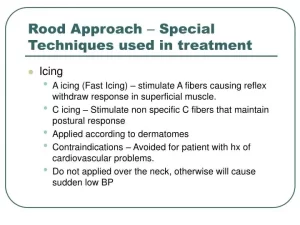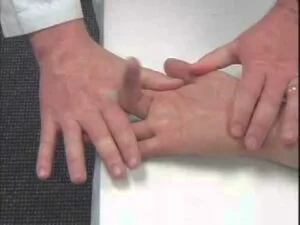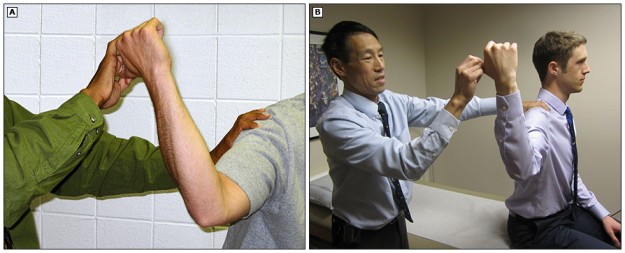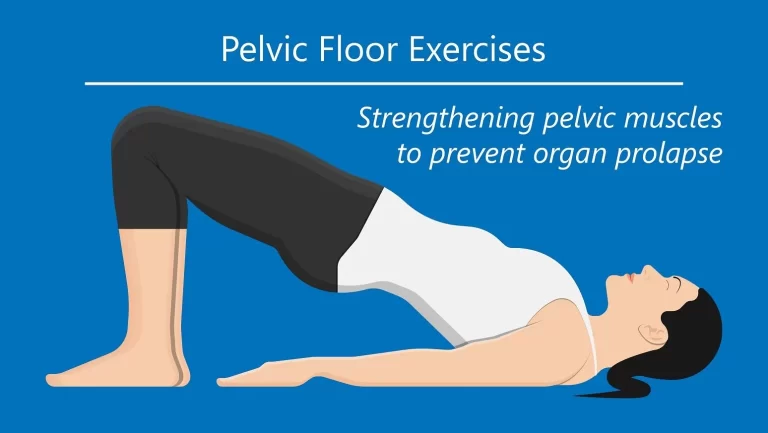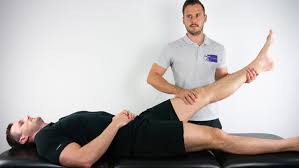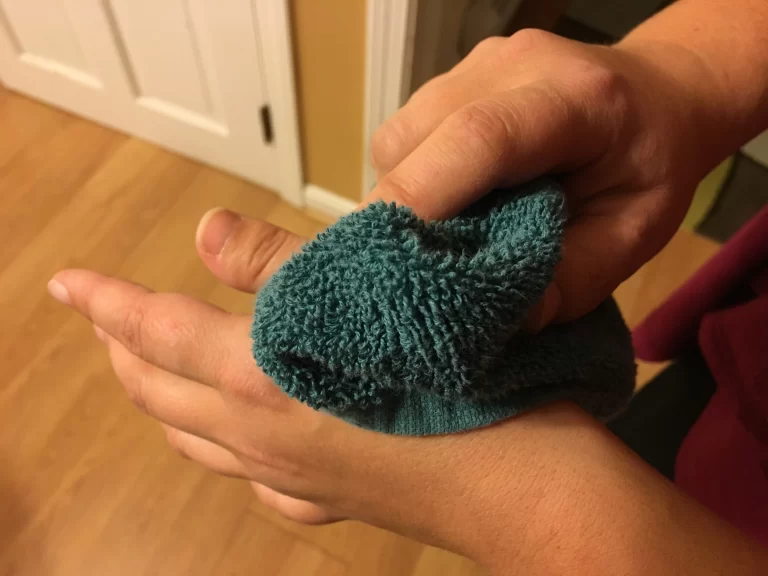Rood’s Approach
What is Rood’s Approach?
Rood’s approach is a neurophysiologic and developmental treatment approach that was developed by Margret Rood to improve the tone of muscles (both flaccid and spastic) in 1940. Rood’s basic theory was that motor patterns are developed from primitive reflexes through proper sensory stimuli to the appropriate sensory receptors in normal sequential developmental patterns to improve motor function.
The basic concepts of Rood’s approach are normalization or improvement of tone, improve developmental sequence, purposeful movement, and repetition or practice. Though her theory started in the 1940s, several revisions go through before she died, and the revision process has still continued till now on the basis of current neuro-scientific practice.
Rood’s approach has always been a topic of criticism due to the insufficient literature available and incomplete background explanations. This paper gives a brief explanation of Rood’s approach and its scientific reconciliation with available literature which shows that many of the basic concepts are still valid and applicable within the current neuro-scientific approach.
Rood’s approach work with the activation or de-activation of sensory receptors, which is concerned with the interaction of somatic, autonomic, and psychic factors and their role in the activation of motor functions.
This neurophysiological approach was designed for patients with motor function-related disabilities. Motor functions and sensory mechanisms are interrelated. The approach is based on the reflex/developmental model of the central nervous system, where the motor function is facilitated or inhibited for rehabilitation purposes.
Rood’s Approach is one of the several other neurophysiology related based neuro-facilitation techniques used by rehabilitation therapists, such as the Brunnstrom technique, proprioceptive neuromuscular facilitation, and neurodevelopmental therapy (also known as NDT or Bobath Approach.
Though Rood’s approach started in the 1940s, several revisions went through before she died. This revision process has continued till now as it still deserves further thought on the basis of current neuro-scientific evidence.
Principles of Rood’s approach:
The basic principles of the Rood’s Approach are:
- Normalization of tone: By giving proper sensory stimuli to get the desired muscular response is the basic principle of the Rood approach (Use of controlled sensory stimulation).
- Gross motor developmental sequence: Rood stated the use of ontogenic developmental progression. According to Rood, sensory-motor control is developmentally based, so that during treatment Physiotherapist must assess the current level of development and then try to reach the next higher levels of control. (Use of developmental sequences)
- Purposeful movement: Rood used various activities that can help to get the wanted movement pattern from the patient. (Use of an activity that gets a purposeful response)
- Repetition of movement: Rood suggested using repetitive movements for good motor learning (Repetition/practice is necessary for motor learning.).
Basic concepts
Rood suggested that sensory input is important to tone muscles and to get desired muscular responses. Sensory stimulus and their relationship to motor movement play an important role in the assessment of dysfunction and in the application of the treatment.
Rood’s four basic concepts are
- Mobility and stability muscles (Tonic and phasic): As per Rood’s approach, muscle groups are divided according to
the type of work they perform and their responses to sensory stimuli.
- Phasic muscles (also known as light work muscles or mobility muscles) are the groups of muscles worked for skilled movement patterns with reciprocal inhibition of antagonist muscles such as the flexors and adductors.
- Tonic muscles (also known as heavy work muscles or stability muscles) are the group of muscles that provide joint stability with co-contraction of muscles that are antagonists in normal movement.
Though some muscles perform both activities -light and heavy, Rood suggested specific things of phasic and
tonic muscles. Phasic muscles are fast glycolytic fiber type, located superficially, and mostly one joint muscle. They have high metabolic costs and are easily fatigued. Tonic muscles are separate from phasic. The Tonic muscles are slow oxidative fibre type, deep located, and mostly single joint type. These Pennate, the large area of attachment muscle, has low metabolic cost and fatigue gradually.
- The Ontogenic Sequence: Rood presents two categories of ontogenic developmental sequences
- The Motor development pattern leads to skilled and finely coordinated movements.
The ontogenic motor patterns are :
- Supine withdrawal
- Roll over
- Pivot prone
- Neck co-contraction.
- Prone on elbow
- Quadruped
- Standing
- Walking
Sequences in Gross Motor Development:
These are gradual developmental sequences that were used as a basis for therapy. These patterns have beneficial effects when combined with Physical therapy treatment sessions and can be used for inhibiting or facilitating by positioning in these patterns.
Supine withdrawal (Supine flexion):
Total flexion response toward chest at the vertebral level of T10.
Flexion of the neck, and crossing the arms and legs protect the anterior surface of the body that’s why this position is protective in nature.
Indication:
- patients with no reciprocal flexion
- this sequence is useful for those who have hyper extensor tone.
Rollover (Toward side lying):
Rollover Toward side-lying is a mobility sequence for extremities and activates the lateral trunk musculature.
Indication:
- Patients who dominated by tonic reflex patterns in supine
- Stimulates semicircular canals which activates the neck & extraocular muscles
Pivot Prone (Prone Extension)
This position requires a full extension of the neck, shoulders, Back, and lower limb. It is difficult to take and maintain. It provides stability as well as mobility. Connected with the labyrinthine righting reaction of the head.
Indication:
Useful position for the trunk upright position and stability.
Neck co-contraction (co-innervation)
It helps to activate both flexors and deep tonic extensors of the neck. this position stimulates tonic labyrinthine righting reaction and also assists stability and extraocular control.
Indication:
When patients require neck stability as well as extraocular control
Prone on elbows:
Taking weight on the elbows position helps to stretch the upper trunk musculature which helps to provide stability to the scapular and glenohumeral regions. Prone on elbows position is inhibitory to the symmetrical tonic neck reflex.
Allows weight shifting from side to side.
Gives better visibility of the environment
Indication:
For those Patients who require to inhibit STNR
All fours limb (quadruped position)
The lower trunk and lower limb are required into a co-contraction sequence. the weight shifting is basic to equilibrium responses.
Sitting position:
In this position, Pressure on the knees to heels helps with Auto facilitation.
Static standing position:
Standing on Both lower extremities with it frees the upper extremity for manipulation, improving the skill of the upper trunk.
It improves higher-level neurological integration, such as righting reactions and equilibrium reactions.
Walking:
Walking requires a stance phase, push-off, swing, heel strike, and stride length. it is a state-of-the-art process requiring coordinated movement patterns of various body parts with weight shifting.
Murray stated that walking requires to support of the body weight, maintaining balance & execute the stepping movement.
Rood’s approach – techniques
It has two main techniques:
- Facilitatory technique
- Inhibitory techniques
Facilitatory techniques
It is very important to improve the tone of flaccid muscles through Tactile stimulation.
Tactile stimulation is given by Fast brushing, Light stroking.
Fast brushing:
It is the fast brushing of skin over the muscle by paint or battery-operated soft brush. Fast Brushing is always directed at muscles to be stimulated. It is a high-intensity stimulation of fast brushing. The stimulation effect is non-specific and reaches a peak in 30 – 40 minutes.
Precautions:
- over outer ear (stimulation of vagus nerve may influence CVS)
- posterior primary rami of L1, L2
- over S2, S3 (may cause bladder retention)
- S4 (used for patients with incontinence)
Light touch:
A light touch is given with the help of fingers or cotton swabs.
It helps to stimulate low threshold receptors by facilitating the extra fugal motor system.
Thermal facilitation – A icing, C icing
A – Icing – application of quick swipes of ice cubes to stimulate withdrawal reflex similar to light touch.
C – icing – continuous threshold stimulus. Done by ice cube pressed for 15 – 20 minutes on the muscle belly or dermatome area.
Precautions are the same as brushing described above.
It is also noticed that brushing and icing have effects on both sides. Thus, stimulation of the unaffected side in hemiplegic patients prior to stimulation of the affected side is also helpful.
Quick light stretch – low initial stimulus which activates phasic response of the same muscle which are stretched. Response to quick stretch is immediate.
Tapping – tapping technique over the tendon or muscle belly is useful in facilitating the muscle action movement.
The tapping technique is the use of a light force applied manually over a tendon or muscle belly to improve voluntary contraction.
Tapping is used to examining reflex activity with a normal response being a brisk muscle contraction. Rood suggested 3 to
5 taps over the muscle belly to facilitate movement.
Pressure – pressure applied on the muscle belly creates stretch on muscle spindles and overall activates a stretch response.
Heavy joint compression-traction – it facilitates co-contraction of all muscles that pass through the joint. Joint compression is applied to a longitudinal axis of the bone. It can be given using manual or weight-bearing positions such as the Prone on hand.
Pressure on the bony prominence
Facilitatory techniques to specialize special senses also includes olfactory and gustatory stimulus.
Inhibitory techniques:
It is used to reduce the tone of muscles mainly the spasticity of muscles
Light joint compression also called joint approximation is used to reduce tone in hypertonic spastic muscles.
Slow stroking – slow stroking of posterior rami with a firm but gradual pressure helps to reduce muscle tone. It is done for three to five minutes until the patient feels relaxed.
Slow rolling of the patient from supine to side lying or slow rocking movements may be useful to reduce muscle spasticity.
Neutral warmth – it is recommended to maintain the body heat by wrapping the affected area to be inhibited it. It is done for ten to twenty minutes.
Neutral heat is used as heat greater than normal body temperature and is useful to create a rebound effect.
Pressure on the insertion point of a muscle inhibits that muscle through the receptors located there.
A gradual long stretch position or maintenance of a lengthened position of spastic muscle for a period of time starting from several minutes to several weeks adjust the muscle spindle to long positions. The balance of tone between agonists and antagonists will be changed if prolonged positioning is allowed.
Unresisted active contraction can be used to inhibit the agonists by way of low threshold GTOs; this would equivalently facilitate the antagonists.

